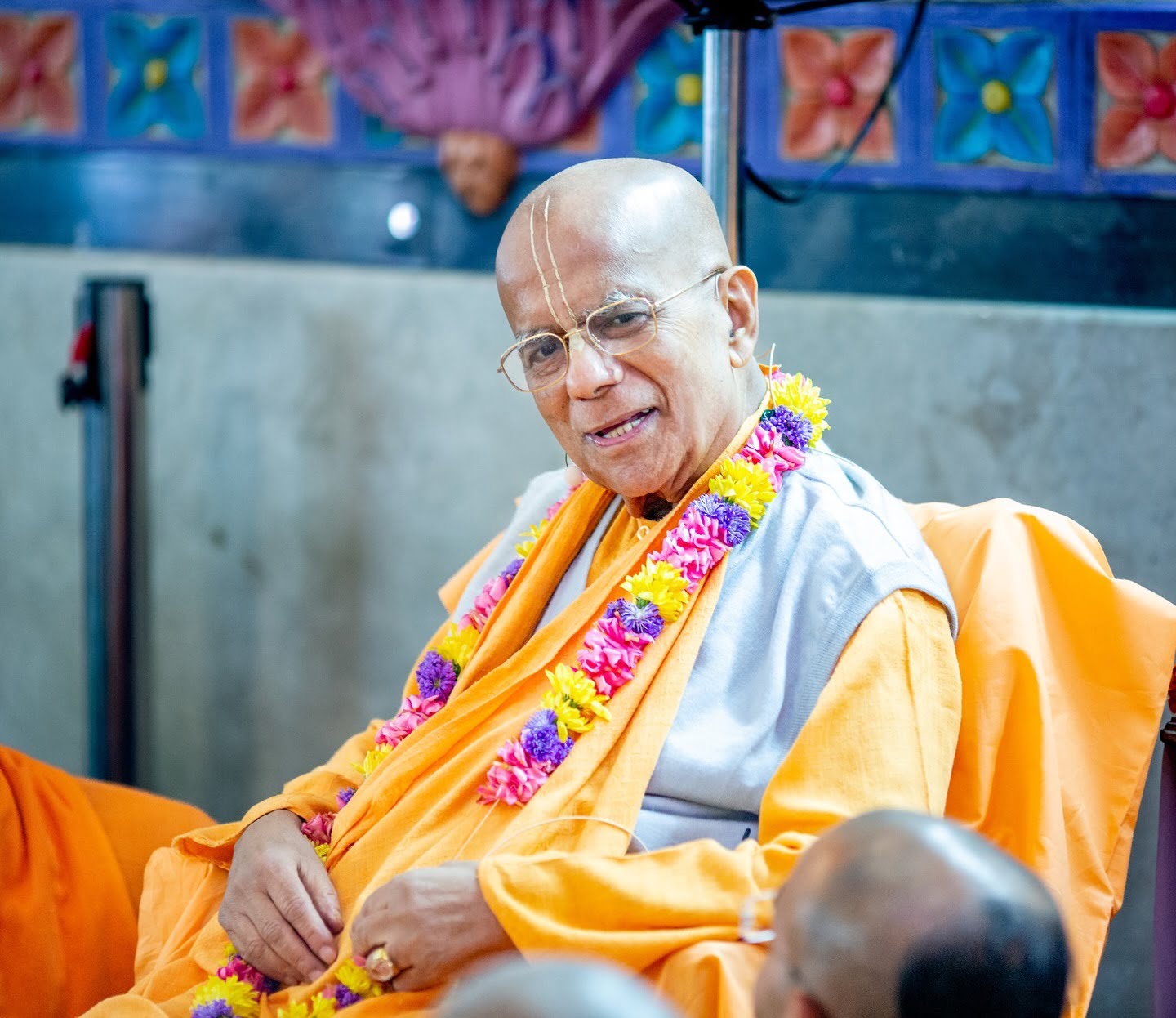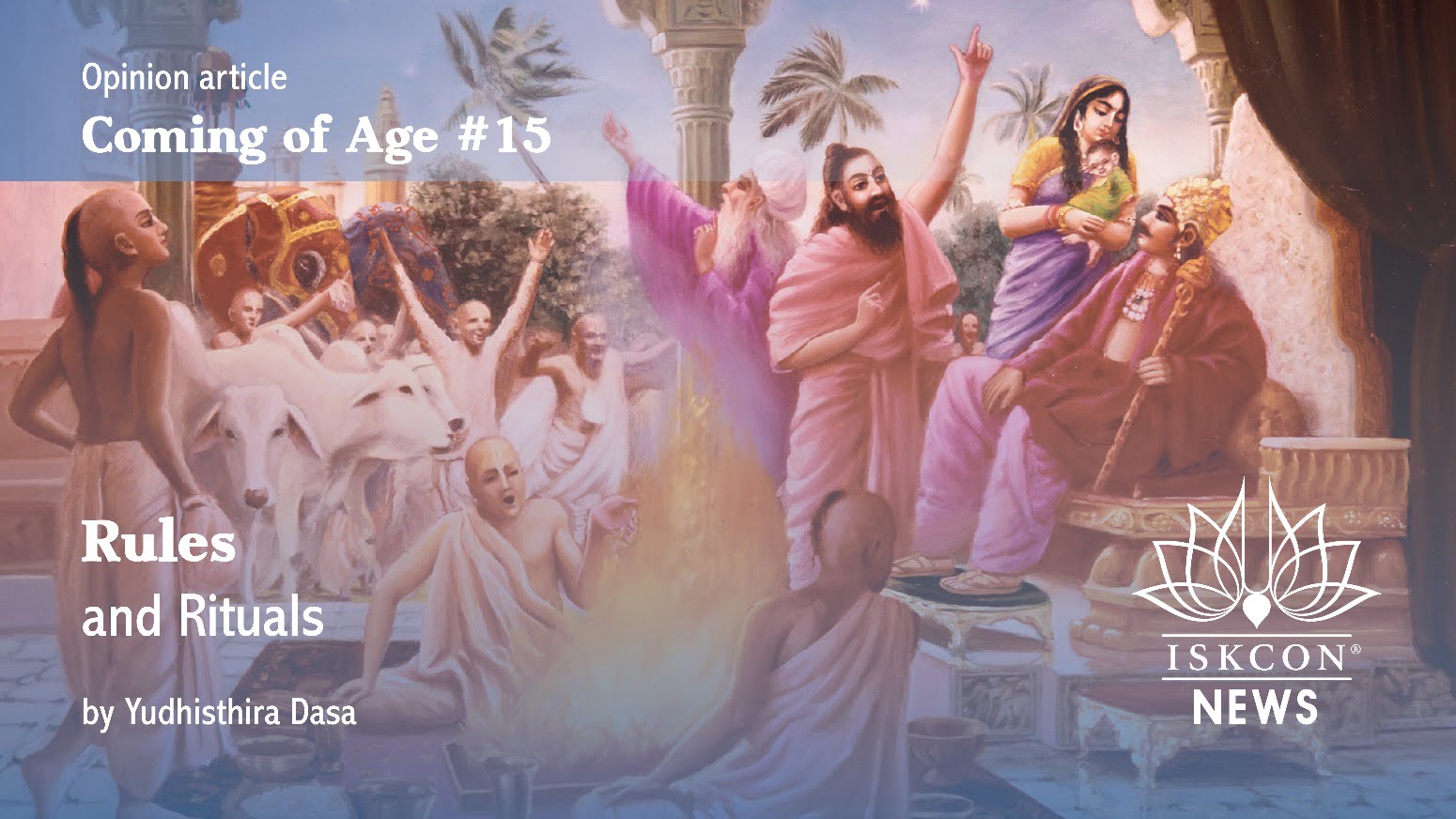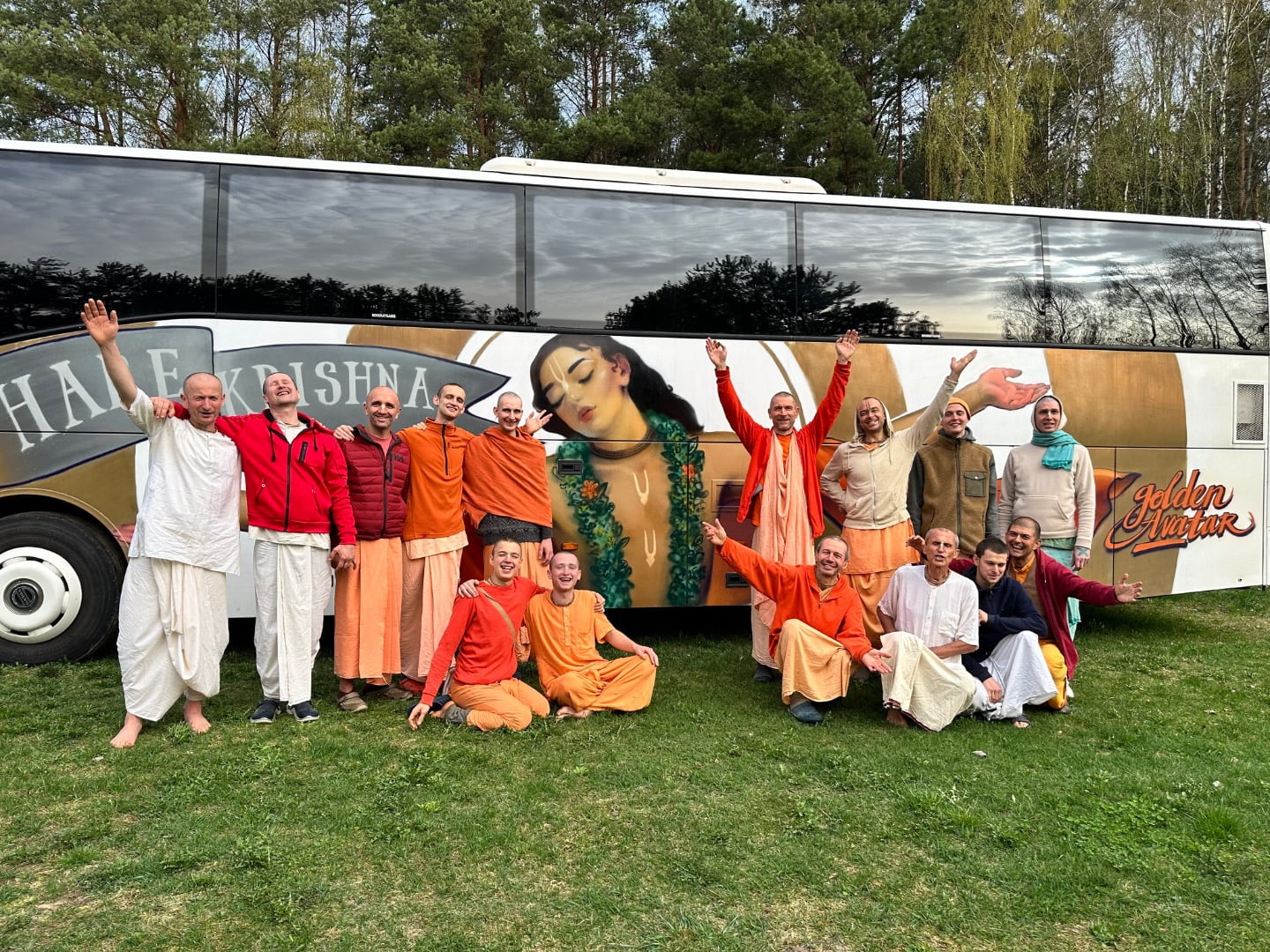Bhaktivedanta Academy: Inspiring Excellence in Krishna’s Children
By Madhava Smullen | Sep 03, 2011

It’s 8:30am when I arrive at the Bhaktivedanta Academy, a private elementary school located on a leafy five-acre plot at ISKCON’s New Raman Reti farm in Alachua, Florida. It’s August 31st, and school has been back in for about a week.
The quiet, peaceful group of mobile home buildings, with its blue and yellow sign depicting a glowing open book with a lotus flower rising out of it, is amongst only a handful of ISKCON schools left in North America. And with fifty-four students, it’s easily the largest.
It’s also one of the most professionally-run devotee schools, and as I enter the compound it’s clear that properly protecting Vaishnava children is a priority here. There’s a barrier blocking the walkway to the classrooms, and like all visitors, I must first sign in at the administrative office with my time and purpose of visit.
There I meet Vishvambhara Dasa, Bhaktivedanta Academy’s Director, who runs the school under a board that includes senior devotees, educators and second generation members.
Vishvambhara joined ISKCON at thirteen, when he and his sister began visiting the temple and brought their mom along with them. As he leads me up to the walkway to the classroom, his professional manner, coupled with an easy, congenial smile makes me feel I’m in the right hands.

The entrance to Bhaktivedanta Academy
“My wife Vrindavanesvari and I moved here from California in 1998, looking for a school for our son,” he explains. “We had planned to only enroll him in Kindergarten here at the New Raman Reti School—as it used to be called—and then send him to the local charter school. But when we saw how beneficial the Krishna conscious learning environment was to him, we couldn’t imagine moving him. We recommitted to the school, and in 2000, I was invited to join its board of directors. At the time, the school, which had been established in 1990, was struggling with only eighteen students and shockingly underpaid teachers.”
Over a decade, Vishvambhara and the rest of the staff worked hard to develop a sustainable, long-term, quality Krishna conscious educational program. And now, things are quite different.
Vishvambhara shows me the outside area where the current fifty-four students assemble at eight every morning, for announcements and a sweet prayer from the Katha Upanishad: “Oh Divine Lord, May we be protected together; May we be nourished together; May we create strength amongst one another.” He then takes me into the mixed Pre-K and Kindergarten class, called Bhakti Bhavan, where three to six year olds begin their learning.
Inside, it’s a hive of activity. Smiling, energetic little children in blue kurta tops and pants are spread out all over the spacious classroom in little groups. The older ones are learning math and language, while the younger ones are engaged in practical tasks designed to learn basic motor skills. I see a tiny boy and girl absorbed in cleaning the floor, one holding the dustpan while the other sweeps. Others are pouring water from a jug into a cup, or learning to tie their shoelaces.

Kindergarten students dress up for the cover of the school’s “Treasure Book.”
It’s all part of the Montessori method of learning, which the school introduced along with its Pre-K program during its first major transition in 2007. Montessori was chosen because of its excellent match with what staff wanted to provide their students in terms of spiritual, academic, social and emotional development.
“The Montesssori method is based on observation of how children learn,” Vishvambhara explains. “And at the Pre-K level, it’s sort of like in the movie the Karate Kid. Remember when Mr. Miyagi gives Daniel all sorts of menial tasks which seem pointless at first, but are actually developing his muscle memory for martial arts? In many ways, our Pre-K is like that: in doing these simple tasks, children are developing the fine motor coordination required to, for instance, hold a pencil and write.”
The Bhaktivedanta Academy also spends a lot of time on its students’ social and emotional development, especially at the foundational Pre-K and lower elementary levels.
“We teach our students a lot about how to deal with the challenges of life, particularly conflict resolution,” says Vishvambhara. “In fact, sometimes I see our students resolving conflicts better than many adults!”
He shows me the “Peace Flower,” a simple rose kept both in the classroom and outside in the playground. When two children have a conflict, they know it’s time for a dialogue, and get the Peace Flower. First one child holds it, and expresses what he’s feeling; then he hands it to the other student, who gets the chance to talk about what’s bothering him.

Two students resolve a conflict as second-gen teacher Nila-Madhava Dasi supervises
“At the end of their conversation, they put the Flower back, say, ‘We declare peace,” and go on their way!” Vishvambhara says. “It’s amazing to see how how effectively it works!”
Next, he takes me into the Audarya Bhavan classroom, home of the first to third grade students. Here, as with all Montessori classrooms, several grades are put together in one class, to create a sense of community and an environment very conducive for growth.
“It’s learning tailored to the individual child,” says Vishvambhara. “Because we have them in one class for three years, it isn’t like typical schools were if you are in first grade, you’re doing first grade work and that’s it. Students that are so inclined can move forward into areas of study that typically wouldn’t be done at their age. And students that might need a little more work in a certain area can do that, without being rushed.”
The classroom doesn’t look like a typical one, either. There are no rigid rows of desks here. Instead, just as in the Pre-K class, the children are sitting in different groups on the floor doing academic work, or bustling about peeling bananas at their snack area. One bright, smiling little boy with the yellow mark of Vaishnava tilak on his forehead approaches me, unabashedly shakes my hand and says, “Welcome to our class!” In a world often deprived of such personal attention, I feel special. It’s a firsthand experience of the powerful social education these kids get.
It’s also indicative of their spiritual training. Spiritual curriculum advisor Nataka Chandrika Dasi sets a Vaishnava ‘Quality of the Month’ which the children learn to imbibe through various Krishna conscious stories, such as honesty, respect, self-control, and service mindedness.
They also chant Hare Krishna, study scriptures, and observe a moment of silence in the mornings in front of the Deities worshipped in every classroom.
“Spirituality is at the core of everything we do here, and we try to integrate Krishna conscious education wherever we can,” Vishvambhara says. “Writing or research projects are spiritually themed, often according to what Vaishnava holy day is coming up on the calendar. And students develop multimedia presentations on various philosophical points from the Bhagavad-gita. Last school year, some students studied the life of ISKCON’s founder Srila Prabhupada, and different groups did presentations on different times in his life, along with dramatic re-enactments.”

Students re-enact Srila Prabhupada’s childhood staging of Rathayatra
Moving on, Vishvambhara and I step quietly into Madhurya Bhavan, the fourth to sixth grade class. Here, children aged nine to twelve are sitting in a circle, having a deep and animated discussion about how the teachings of the Bhagavad-gita apply practically to their lives. At this upper elementary level, Vishvambhara tells me, students are encouraged to make personal commitments toward their own spiritual practices.
The class is being taught by Shantipur Dasi, who is one of the Bhaktivedanta Academy’s six ISKCON second generation teachers, and was educated here herself back when it was known as the New Raman Reti School.
“We have a great mix here,” says Vishvambhara. “On the one hand, we have some veteran Gurukula teachers such as Satyaki Dasi and Nataka Chandrika Dasi, who have taught at ISKCON schools all over the country for many years, and have a wealth of knowledge and experience. And on the other hand, we have our younger teachers who have grown up in the Gurukula system, and can give firsthand feedback on what they liked and what needs to be changed.”
This gives the Bhaktivedanta Academy a unique advantage in ensuring that it does not repeat the mistakes of the ISKCON school system’s past. At staff meetings, a veteran teacher might relate their experience in a certain teaching method. Then, second generation teachers—who were once their students—may say whether it was effective for them or not.
“For instance, through such meetings, we found that the typical gurukula experience of just reading through the Bhagavad-gita in a linear fashion was not very effective for students,” Vishvambhara says. “They did gain real knowledge and interest, however, from researching specific philosophical points and doing projects based on them. So that’s what we do.”
As well as their unique experiences, all elementary teachers at the Bhaktivedanta Academy have four year degrees and Montessori certifications. Such qualified teachers were attracted by the second major transition made by the school in 2008, when it was given the name Bhaktivedanta Academy.
“Before that, teachers at the school were committing so much of their time and energy, and getting paid barely anything—as little as $600 a month for a full-time lead teacher,” says Vishvambhara. “Historically, teachers are underpaid everywhere, but in ISKCON the situation was much worse. But you can’t look at a school from the perspective of, ‘What’s the bare minimum we can pay everyone to keep this thing going?’ We’re working towards excellence. And I feel strongly that devotees making the commitment to education need to be sustained in realistic ways. So we significantly raised salaries.”
As a result of this, as well as the ongoing teacher training Bhaktivedanta Academy offers, both young teachers like Shantipur and veteran ones like Nataka-Chandrika saw teaching in a Krishna conscious school as a viable career option.

Teacher Nataka Chandrika Dasi with students
“That’s some indication that we’re on the right track, but we still have some ways to go,” Vishvambhara says.
Of course, paying the teachers more meant charging higher tuition. But the Bhaktivedanta Academy decided that rather than having “artificially low” overall tuition rates, a better option would be to set rates that would ensure the school’s long term sustainability, and then provide financial assistance when necessary to families that needed it.
“We participate in the Florida government’s tax credit scholarship program, one of the few in the country that provides funding for low-income families to put their children in private schools,” says Vishvambhara. “As a result, many families who really want a first class Krishna conscious and academic program for their children, but who normally wouldn’t be able to afford it, can.”
Also helping the Bhaktivedanta Academy’s long-term sustainability and standards of excellence is the support from the local Alachua community—the largest ISKCON community in North America—who volunteer not only their time and services, but also their funds. Every spring, the school holds ticketed fundraising events with a gourmet dinner and a stage show featuring the best in ISKCON entertainment, and ending with an appeal. In the past three years, it has raised $60,000 through these events.

Jagannath Kirtan Dasa and daughter Thakurani on Father’s Day at the school
“One of our fundraising goals, which we are achieving this year, was to bring new technology into the classrooms,” says Vishvambhara. “What we had before was extremely antiquated—our computers were hand-me-downs of hand-me-downs! We felt bad, because we live in a very technological world, and it was important to us to give our students the training they needed to excel beyond school. So this year, we have two new iMacs in each class, and two new big screen digital presentation systems, which will be used for the students’ regular multimedia presentations. We are also supplying the teachers with iPads, which will later be gradually introduced to the students.”
The high level of both material and spiritual education at Bhaktivedanta Academy has been a major factor in attracting families from all over the country to live in Alachua—over the past three years, eight families have moved to the community.
“There’s a certain synergy—our school has contributed to the growth of the community, and in turn the large community here has helped us grow and develop the school,” Vishvambhara says.
In fact, each of the Bhaktivedanta Academy’s three classrooms are expanding to capacity, and will soon be full, requiring new, bigger buildings. The management estimates that an increase from the current fifty-four students to seventy is needed for the school to become fully viable, and that goal is expected to be reached in the next few years.

Grandparents’ day—many of the children at Bhaktivedanta Academy are third generation devotees
In addition, Bhaktivedanta Academy aims to introduce its own middle school program by the time its current sixth grade students are ready to move into seventh grade—in the fall of 2013.
The long term plan is to provide a Krishna conscious education for children all the way from Pre-K to high school, although there’s no rush. For Bhaktivedanta Academy, the priority is to establish excellence at each level of education without prematurely moving forward.
“We don’t want to have a high school for the sake of it,” Vishvambhara says. “We want a high school because it’s going to be a great high school. One day, I see ISKCON having such a good reputation for running quality educational programs, that even those conscious parents who are not devotees will enroll their children in our schools. Presidents send their sons and daughters to the Sidwell Friends school in Washington D.C., although it is run by the Quakers, because it is such a prestigious school.”
He pauses, and smiles. “One day, that could be us.”

Happy students and teachers at Bhaktivedanta Academy
For more information, please visit http://www.bhaktivedantaacademy.org.














